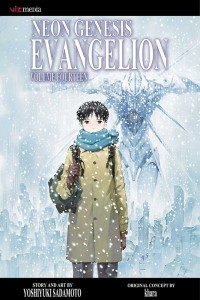By Yoshiyuki Sadamoto and GAINAX. Released in Japan by Kadokawa Shoten, serialized in the magazine Young Ace. Released in North America by Viz Media.
(This review contains spoilers.)
A journey that began in Japan back in 1995, and in North America approximately 2004 I think (it’s been so long), has finally come to an end with this final volume of Neon Genesis Evangelion. It’s only out digitally for the moment, as the volume was only released last week in Japan. Print volumes should be arriving in February, but I can’t wait that long, so let’s swipe at our tablets and find out what happens. I think we all have the same question: we know the manga is following the same beats as the anime did, but is it also going to end with Shinji strangling Asuka on some godforsaken (literally) beach?
Thankfully, the answer turns out to be no. Now don’t get me wrong – everyone still ends up in orange goo here. Makoto gets to see Misato before he dissolves, and Maya gets Ritsuko. Sadly, Aoba isn’t heavily crushing on anyone special, so he just gets dogpiled by a bunch of Rei clones. We see Gendo finally die, and it’s notable that he does NOT dissolve like everyone else – but wait till later. In the end, all is nothingness, and Rei presents this nothingness to Shinji as what Gendo has been shooting for – and what Shinji has wanted as well. To run away, to give in, to be accepted in the same nothingness as everyone else. No war, no hatred, no love, no peace – it’s all one. (There is a fantastic two-page spread showing Shinji seeing dialogue bubbles of the entirety of human experience – acceptance and rejection all in one.)
Shinji in the manga has gone through a lot of stuff, but in the end he rejects this world – and tells Rei why, in no uncertain terms. Rei describes it as a happy world, but Shinji points out that in a world that is nothing, happiness can’t exist. This too is familiar from the anime, but these scenes in the manga end up being pretty heartwarming. He recalls Yui telling him that he has to protect the happiness of everyone in the world – which means the sadness as well. After essentially saying goodbye to Rei (who I think makes it clear that if he rejects Third Impact she is not going to be around), we get one of the more iconic shots of Evangelion, which is Unit 01 emerging from Lilith’s giant eyeball.
The apocalypse gets to take up a good chunk of space, but when it’s over, and Shinji sees both Yui and Gendo in what looks like the afterlife telling him to stand on his own two feet (dammit, why a happy ending for Gendo? Grump), we see that Rei essentially rebooted the world, as things pick up with an older Shinji about to take a train into Tokyo for high school exams. This is, thank GOD, nothing whatsoever like the wacky romantic comedy universe of Episode 26, or even The Shinji Ikari Raising Project. Yes, he meets Asuka in a cute way, but it’s fairly reserved and there is no falling into anyone’s chest. It’s a new beginning, and is combined with his seeing Kensuke to show that this is what Rei and Shinji wanted. Here he can make new connections and form new bonds. Helpfully, there are also no duels in giant robots (we see the remains of the Evas describes as mysterious remnants), so it’s entirely possible that this will come to pass.
And that’s that. (There is a final chapter, which introduces Mari Illustrious Makinami as a high school classmate of Yui’s with a crush, but it’s pretty slight, and feels like an attempt to shoehorn the very popular Mari into the main manga series.) I’ve always read the manga wanting a somewhat less hopeless take on the human race. And that’s what we get here. It’s not Shinji and Asuka as Adam and Eve, it’s a chance to start anew, given by a girl who learned how to reach out and care for others thanks to Shinji’s empathy. Evangelion is a good story, well told, and I am happy that it ends like this. Well done.


Speak Your Mind